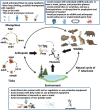Non-vaccinal prophylaxis of tularemia
- PMID: 39669787
- PMCID: PMC11635305
- DOI: 10.3389/fmicb.2024.1507469
Non-vaccinal prophylaxis of tularemia
Abstract
Tularemia is a re-emerging zoonosis in many endemic countries. It is caused by Francisella tularensis, a gram-negative bacterium and biological threat agent. Humans are infected from the wild animal reservoir, the environmental reservoir or by the bite of arthropod vectors. This infection occurs through the cutaneous, conjunctival, digestive or respiratory routes. Tularemia generally manifests itself as an infection at the site of entry of the bacteria with regional lymphadenopathy, or as a systemic disease, particularly pulmonary. It is often a debilitating condition due to persistent symptoms and sometimes a life-threatening condition. There is effective antibiotic treatment for this disease but no vaccine is currently available for humans or animals. Due to the complexity of the F. tularensis life cycle and multiple modes of human infection, non-vaccine prophylaxis of tularemia is complex and poorly defined. In this review, we summarize the various individual prophylactic measures available against tularemia based on the different risk factors associated with the disease. We also discuss the currently underdeveloped possibilities for collective prophylaxis. Prophylactic measures must be adapted in each tularemia endemic area according to the predominant modes of human and animal infection. They requires a One Health approach to control both animal and environmental reservoirs of F. tularensis, as well as arthropod vectors, to slow the current expansion of endemic areas of this disease in a context of climate change.
Keywords: Francisella tularensis; antibiotic prophylaxis; arthropod-borne diseases; occupational disease; prophylaxis; risk factors; tularemia; zoonosis.
Copyright © 2024 Maurin, Hennebique, Brunet, Pondérand, Pelloux, Boisset and Caspar.
Conflict of interest statement
The authors declare that the research was conducted in the absence of any commercial or financial relationships that could be construed as a potential conflict of interest. The author(s) declared that they were an editorial board member of Frontiers, at the time of submission. This had no impact on the peer review process and the final decision.
Figures
References
-
- Alibek K., Handelman S. (1999). Biohazard: The chilling true story of the largest covert biological weapons program in the world--told from the inside by the man who ran it. 1st Edt. New York, NY, USA: Random House.
Publication types
LinkOut - more resources
Full Text Sources


